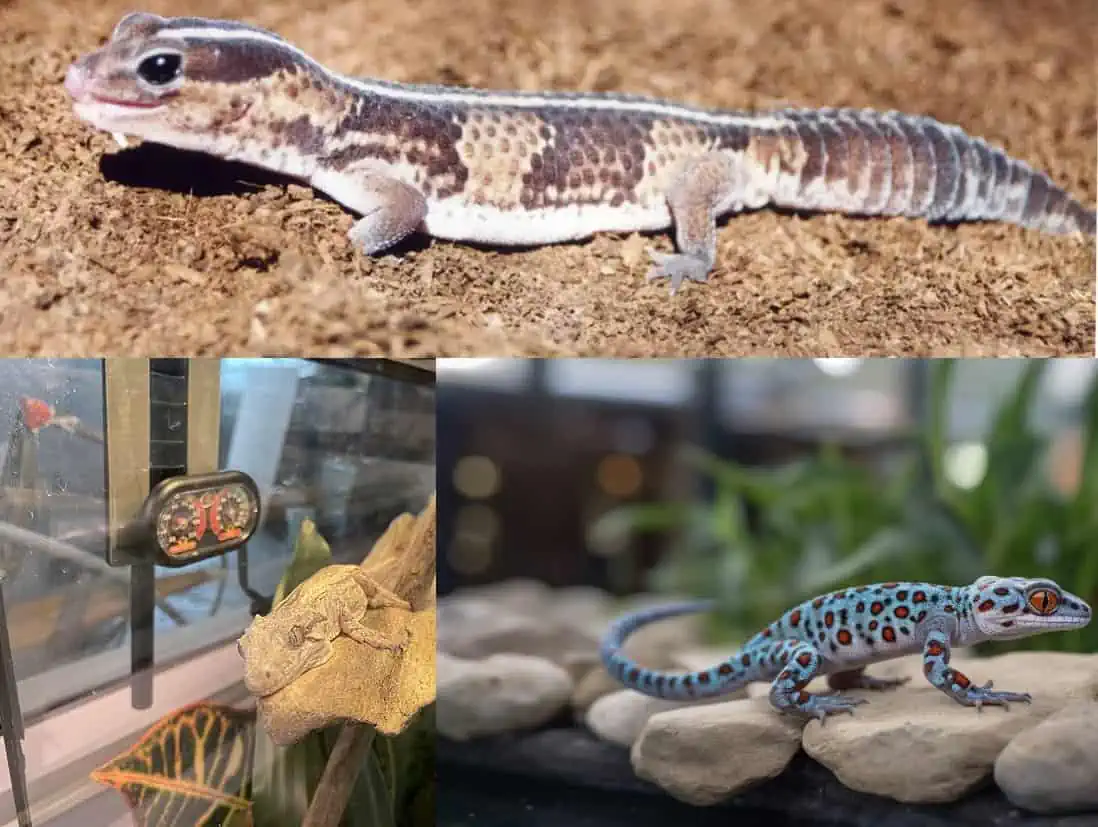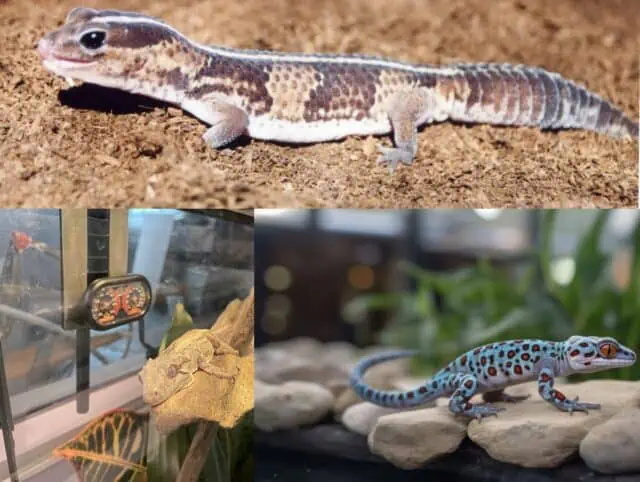Welcome to our detailed guide comparing the Tokay Gecko and the Common House Gecko as pets. With an increasing interest in reptile companionship, it’s essential to understand the unique characteristics, needs, and behaviors of different reptile species. Geckos, with their intriguing personalities and relatively manageable care, have become popular choices among enthusiasts.
In this article, we’ll delve into a comprehensive comparison between the Tokay Gecko and the Common House Gecko, covering everything from their natural habitats to their temperaments. Whether you’re an experienced reptile lover or someone looking to dive into this exciting world for the first time, this guide is here to help you make an informed decision.
Brief Description and Natural Habitats
Tokay Gecko
The Tokay Gecko (Gekko gecko) is a large, robust species that is known for its striking coloration and bold markings. Their bodies feature a brilliant blue or grayish background adorned with red or orange spots, a characteristic that has earned them a lot of admiration in the reptile world. Originally, these geckos are native to Southeast Asia and parts of the Pacific, including the Philippines, New Guinea, and Indonesia. They usually inhabit rainforests and are known for their distinct vocalization, which sounds like “To-kay! To-kay!”, hence the name.
Common House Gecko
On the other hand, the Common House Gecko (Hemidactylus frenatus) is smaller and more discreet in color, usually exhibiting a grayish or pale brown body with varying patterns. They are extremely adaptable creatures and have successfully colonized various parts of the world, from Africa and Asia to Australia and the Americas. As their name suggests, these geckos often live in close proximity to human dwellings, thriving in urban and suburban settings where they can find plenty of insects to eat. Despite their less flashy appearance compared to the Tokay Gecko, their resilient nature and unobtrusive habits make them an intriguing choice for reptile enthusiasts.
Lifespan and Size
Tokay Gecko
Tokay Geckos are one of the largest gecko species, typically reaching lengths of 11 to 15 inches when fully grown. Their solid build combined with a striking coloration gives them a distinct, imposing appearance. As for their lifespan, when cared for properly, Tokay Geckos can live between 10 to 15 years in captivity. This makes them a long-term commitment, which potential owners should be prepared for.
Common House Gecko
The Common House Gecko, in contrast, is a smaller species, with adults usually measuring between 3 to 6 inches in length. Their smaller size makes them easier to house and manage, which can be an advantage for people with limited space or for those who are new to keeping reptiles. When it comes to lifespan, these geckos, with proper care, can live around 5 to 8 years in captivity. This is a shorter commitment compared to the Tokay Gecko, which may suit certain prospective pet owners better.
Care and Maintenance
Housing
Tokay Gecko
The size and energetic nature of Tokay Geckos require a spacious enclosure. A 20-gallon tank (minimum) should be used for a single gecko, while larger ones would be needed for multiple geckos. Vertical space is vital as these geckos are arboreal and enjoy climbing. Include a variety of branches, vines, and hide spots in the tank to mimic their natural habitat. Maintaining the correct temperature and humidity is also critical. An ambient temperature of 80-85 degrees Fahrenheit during the day and 70-75 degrees at night should be maintained. The humidity should be around 60-80%, achievable by misting the enclosure regularly.
Common House Gecko
Common House Geckos need a smaller enclosure due to their size. A 10-gallon tank would suffice for a single gecko, but as with Tokay Geckos, a larger tank is necessary if keeping multiple geckos. As they are also climbers, vertical space with branches and hides is necessary. The ambient temperature range for these geckos should be 75-85 degrees during the day and can drop to around 70 degrees at night. They prefer slightly lower humidity levels than Tokay Geckos, generally between 50-70%.
Diet and Nutrition
Tokay Gecko
Tokay Geckos are insectivores, and their diet should consist of a variety of insects like crickets, mealworms, roaches, and occasional treat of pinkie mice for adult geckos. Gut-load the insects before feeding and dust them with a quality calcium and vitamin D3 supplement to ensure the gecko receives proper nutrition.
Common House Gecko
Like the Tokay, the Common House Gecko is an insectivore and requires a similar diet. However, due to their smaller size, they should be offered smaller prey items. They can be fed small crickets, fruit flies, and small mealworms. As with Tokay Geckos, it’s essential to gut-load the insects and dust them with nutritional supplements.
Health and Medical Considerations
Tokay Gecko
Tokay Geckos are relatively robust, but like any pet, they can suffer from various health issues such as respiratory infections, impaction due to improper substrate, and metabolic bone disease from insufficient calcium or UVB exposure. Regular veterinary check-ups and maintaining proper living conditions can help prevent most of these issues.
Common House Gecko
Common House Geckos face similar health issues to Tokay Geckos, including respiratory infections, impaction, and metabolic bone disease. However, due to their smaller size, they can be more sensitive to changes in their environment, making correct husbandry especially crucial for this species. Regular vet check-ups are also necessary for these geckos to ensure they remain healthy.
The care requirements for these two gecko species vary slightly due to their size and natural habitats.
Temperament and Behavior
Tokay Gecko
Tokay Geckos have a reputation for being feisty and aggressive. They are not typically a “handling” pet and can bite when they feel threatened, which can be quite painful due to their strong jaws. Their defensive nature makes them less suitable for owners who want a reptile to interact closely with. However, for those content to observe their gecko’s behavior within its enclosure, Tokay Geckos can exhibit fascinating behaviors and vocalizations that make them unique pets.
Common House Gecko
Common House Geckos are more secretive and shy compared to Tokay Geckos. They are nocturnal and are most active during the evening and night hours. While they also are not typically comfortable with frequent handling, they are usually less aggressive and less likely to bite. Their elusive nature might not provide the interactive experience some owners might seek, but watching their night-time activity can be a pleasure in itself.
It’s worth mentioning that the temperament of individual geckos can vary, and regular, gentle handling from a young age can help your pet become more comfortable with human interaction. However, it’s always essential to respect the natural instincts and comfort zones of your gecko, whether it’s a Tokay or a Common House Gecko. In the next section, we’ll dive into the world of gecko breeding, outlining what prospective owners need to know about this aspect of gecko ownership.
Breeding
Tokay Gecko
Breeding Tokay Geckos can be a challenging yet rewarding experience. They are oviparous, laying clutches of one or two hard-shelled eggs. The female will usually lay her eggs in hidden, secure locations within the enclosure. These geckos are known for their maternal instincts; females guard their eggs fiercely until they hatch, a unique trait among geckos. If you’re considering breeding, be aware that a gravid (pregnant) female will require additional care and nutrition, and you should be prepared for potential aggressive behavior during this time.
Common House Gecko
Common House Geckos are also oviparous and typically lay clutches of two eggs. Unlike Tokay Geckos, Common House Geckos do not guard their eggs. Instead, the female will stick her eggs in hidden, secure locations and leave them to incubate. Once laid, the eggs can take between 45-60 days to hatch in appropriate conditions. If you’re planning to breed Common House Geckos, make sure to provide plenty of suitable egg-laying sites within the enclosure and be prepared to care for the hatchlings once they emerge.
Legal and Ethical Considerations
Tokay Gecko
While it’s generally legal to own a Tokay Gecko in many areas, some regions may have restrictions or requirements for permits due to the potential invasive nature of the species if released into non-native habitats. It’s essential to research local laws and regulations before deciding to adopt a Tokay Gecko. Ethically, make sure to source your Tokay Gecko from reputable breeders to discourage the practice of capturing these geckos from the wild, which can have negative impacts on their native populations.
Common House Gecko
The Common House Gecko also faces potential legal restrictions in some regions due to the same concerns about their potential as an invasive species. Always do your due diligence in researching local laws and regulations. Ethically, similar rules apply. Always aim to source your Common House Gecko from reputable breeders rather than supporting the capture and trade of wild specimens.
Pros and Cons of Each Gecko as a Pet
Tokay Gecko
Pros:
Visually striking: Their unique, bright coloration makes them an attractive choice for many reptile enthusiasts.
Long lifespan: They can live up to 10-15 years, providing a long-term companionship for their owners.
Interesting behaviors: Their vocalizations and defensive displays can be fascinating to observe.
Cons:
Aggressive temperament: They are known to be feisty and are not typically comfortable with handling, which might be a downside for owners looking for a more interactive pet.
Larger size: Their larger size means they require more space and larger prey, which can be more demanding in terms of care and maintenance.
Common House Gecko
Pros:
Smaller size: Their small size makes them easier to house and manage, making them a suitable choice for beginners or those with limited space.
Adaptable: They are extremely adaptable and resilient, which can make them somewhat easier to care for.
Cons:
Shy and elusive: They are more secretive, and their nocturnal nature means they might not be as visible or interactive as some owners might like.
Shorter lifespan: With a lifespan of around 5-8 years, they might not provide the long-term companionship some owners might seek.






